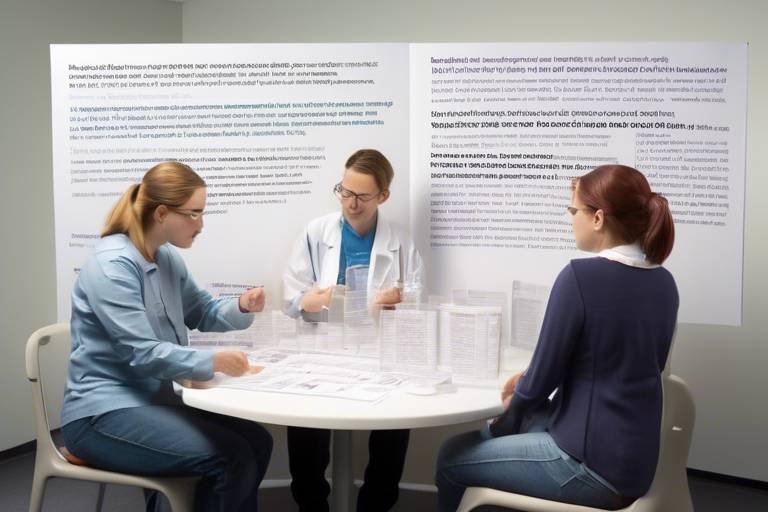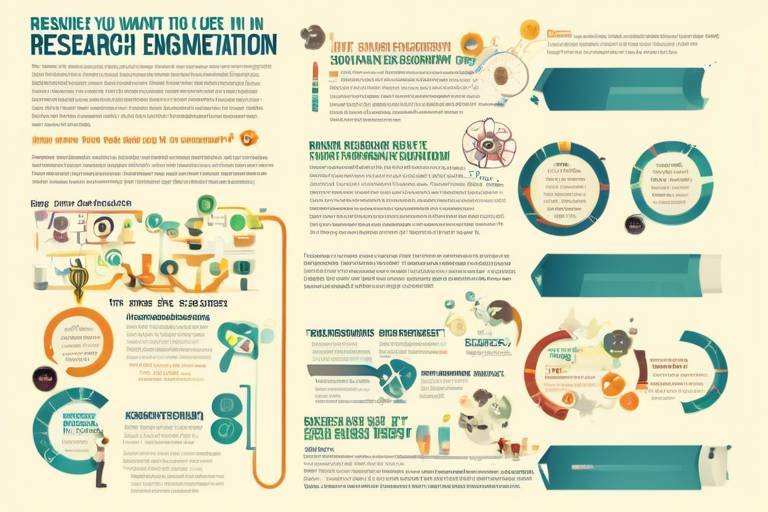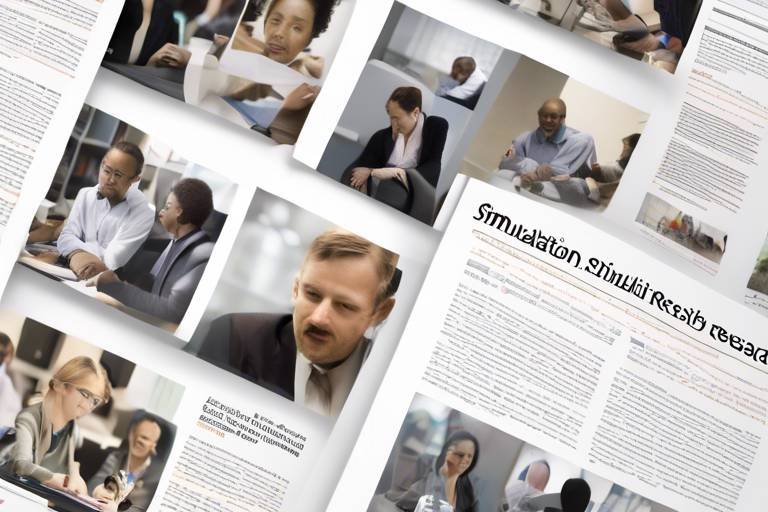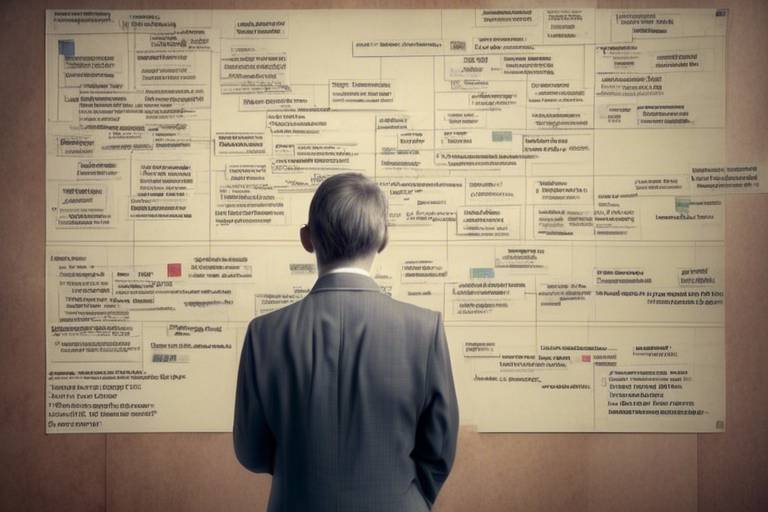The Benefits of Using Simulation in Research Studies
In today’s fast-paced world, research methodologies are evolving at a breakneck speed. One of the most significant advancements in this arena is the use of simulation. But what exactly does this mean for researchers and their studies? Well, imagine being able to experiment and gather data without the constraints of the physical world. That’s the magic of simulation! It not only enhances research methodologies but also improves data accuracy, provides a safe environment for experimentation, and ultimately leads to more reliable and insightful outcomes across various fields. Let’s dive deeper into how simulation is revolutionizing research.
When it comes to research, accuracy is everything. Simulation allows researchers to model complex systems, leading to enhanced data accuracy. By replicating real-world scenarios, simulations can significantly reduce errors and provide more precise results than traditional methods. Think about it: instead of relying on potentially flawed physical experiments, researchers can create virtual environments where they control every variable. This means that the data collected is not only more reliable but also more relevant to real-world applications. In a world where decisions are often based on data, having accurate figures is akin to having a treasure map in a treasure hunt!
Another remarkable advantage of utilizing simulation in research is its cost-effectiveness. By minimizing the need for physical resources and enabling virtual testing, researchers can allocate funds more efficiently. This means they can focus their budgets on critical aspects of their studies without compromising quality. Imagine a scenario where a researcher needs to conduct various experiments but is limited by funding. With simulation, they can conduct multiple tests virtually, drastically reducing costs. It’s like having a buffet of research opportunities without breaking the bank!
Simulations require fewer physical materials, which helps in conserving resources. This reduction not only benefits the environment but also allows researchers to focus on critical aspects of their studies without excess expenditure. For instance, in fields like biology or chemistry, where experiments can often require expensive reagents or materials, simulations allow for the exploration of hypotheses without the need for these costly items. This is not just smart; it’s a responsible approach to research in an age where sustainability is paramount.
By decreasing the reliance on physical experiments, simulations contribute to a lower environmental footprint. This approach aligns research with sustainable practices, promoting ecological responsibility within scientific communities. Imagine if every research lab adopted simulation techniques; the reduction in waste and resource consumption could be monumental! It’s a win-win situation: researchers achieve their goals while also being stewards of the planet.
Time is often the most precious resource in research. Simulations can accelerate the research process by allowing multiple scenarios to be tested simultaneously. This efficiency enables researchers to gather insights faster, leading to quicker decision-making and implementation of findings. Think of it as having a superpower: instead of waiting weeks or months for results from physical tests, researchers can run simulations and get instant feedback. It’s like fast-forwarding through the tedious parts of a movie to get to the exciting climax!
Safety is a critical concern in many research fields, particularly in medicine and engineering. Simulation provides a safe environment for testing potentially hazardous scenarios. Researchers can explore dangerous situations without real-world risks, making it an invaluable tool. Imagine a medical researcher testing a new surgical procedure; with simulation, they can practice and refine their technique without risking patient safety. It’s like having a training ground where all the risks are mitigated!
One of the standout features of simulation is its unparalleled flexibility. Researchers can easily modify variables and explore a wide range of conditions. This adaptability fosters creativity and innovation in experimental design. For example, if a researcher wants to test how different temperatures affect a chemical reaction, they can simply adjust the settings in the simulation. No need for lengthy setup times or costly materials—just pure experimentation at its finest!
Researchers can create various hypothetical scenarios within simulations, enabling them to assess outcomes under different conditions. This capability enhances understanding and prepares for real-world applications. It’s like being able to play out different endings of a story before committing to one; researchers can explore multiple paths and choose the best course of action based on data-driven insights.
Simulations allow for real-time data analysis and adjustments, ensuring that researchers can respond to unexpected results immediately. This dynamic approach optimizes the research process and improves overall study quality. Imagine conducting an experiment and discovering an anomaly; with simulation, you can tweak the parameters on the fly and see how the results change instantly. It’s the ultimate research hack!
Simulation techniques are applicable across various disciplines, from healthcare to engineering. This versatility encourages collaboration and knowledge sharing among researchers, leading to groundbreaking discoveries. It’s like a melting pot of ideas where different fields converge to create innovative solutions. Whether it’s modeling patient outcomes in healthcare or testing designs in engineering, the possibilities are endless!
In healthcare, simulations are used to model patient outcomes and treatment effects. This innovation aids in developing new therapies and improving existing practices, ultimately enhancing patient care. For instance, before a new drug hits the market, researchers can simulate its effects on various populations to predict outcomes and side effects. It’s a proactive approach that can save lives!
In engineering, simulations allow for testing designs under various conditions before physical prototypes are built. This process reduces costs and time while ensuring safety and functionality in final products. Picture an engineer designing a new bridge; through simulation, they can test how it withstands different weather conditions and loads without ever lifting a single beam. It’s like having a crystal ball that shows the future of their design!
- What is simulation in research? Simulation in research refers to the use of models to replicate real-world processes or systems, allowing researchers to conduct experiments in a controlled virtual environment.
- How does simulation improve data accuracy? By replicating real-world scenarios and controlling variables, simulations can significantly reduce errors and provide more precise results compared to traditional methods.
- Is simulation cost-effective? Yes, simulations can lower research costs by minimizing the need for physical resources and enabling virtual testing, allowing researchers to allocate funds more efficiently.
- What are the safety benefits of simulation? Simulations provide a safe environment for testing potentially hazardous scenarios, allowing researchers to explore dangerous situations without real-world risks.

Improved Data Accuracy
This article explores how simulation enhances research methodologies, improves data accuracy, and provides a safe environment for experimentation, ultimately leading to more reliable and insightful outcomes in various fields.
In today's fast-paced research landscape, the need for precision and accuracy has never been more critical. Simulation technology allows researchers to create intricate models of real-world systems, thereby enhancing data accuracy significantly. Imagine trying to predict the weather without the aid of advanced models; it would be like trying to hit a bullseye blindfolded! By replicating real-world scenarios, simulations can reduce errors and provide more precise results than traditional methods.
One of the standout features of simulation is its ability to conduct experiments in a controlled environment. This means researchers can tweak variables and parameters to see how they affect outcomes without the chaos of uncontrolled real-world variables. For instance, in a medical study, researchers can simulate the effects of a new drug on a virtual population, allowing them to observe potential side effects and efficacy before any human trials. This not only saves time but also ensures that the data collected is as accurate as possible.
Moreover, simulations can incorporate vast amounts of data from various sources, which can be analyzed to identify trends and correlations that might not be evident through traditional methods. This capability is especially valuable in fields like climate science, where researchers can simulate complex interactions within the Earth's systems. By doing so, they can generate predictions about future climate conditions with a higher degree of reliability.
To illustrate the impact of simulation on data accuracy, consider the following table:
| Method | Data Accuracy | Typical Use Cases |
|---|---|---|
| Traditional Methods | Moderate | Field studies, manual experiments |
| Simulation | High | Modeling complex systems, virtual testing |
As you can see, the leap in data accuracy when utilizing simulations is significant. This improvement is not just a matter of numbers; it translates into better-informed decisions and more effective solutions across various disciplines. In essence, simulations empower researchers to explore the unknown with confidence, making them an invaluable tool in the pursuit of knowledge.
Utilizing simulation can significantly lower research costs. By minimizing the need for physical resources and enabling virtual testing, researchers can allocate funds more efficiently without compromising the quality of their studies.
Simulations require fewer physical materials, which helps in conserving resources. This reduction not only benefits the environment but also allows researchers to focus on critical aspects of their studies without excess expenditure.
By decreasing the reliance on physical experiments, simulations contribute to a lower environmental footprint. This approach aligns research with sustainable practices, promoting ecological responsibility within scientific communities.
Simulations can accelerate the research process by allowing multiple scenarios to be tested simultaneously. This efficiency enables researchers to gather insights faster, leading to quicker decision-making and implementation of findings.
Simulation provides a safe environment for testing potentially hazardous scenarios. Researchers can explore dangerous situations without real-world risks, making it an invaluable tool in fields like medicine and engineering.
Simulations offer unparalleled flexibility, allowing researchers to modify variables easily and explore a wide range of conditions. This adaptability fosters creativity and innovation in experimental design.
Researchers can create various hypothetical scenarios within simulations, enabling them to assess outcomes under different conditions. This capability enhances understanding and prepares for real-world applications.
Simulations allow for real-time data analysis and adjustments, ensuring that researchers can respond to unexpected results immediately. This dynamic approach optimizes the research process and improves overall study quality.
Simulation techniques are applicable across various disciplines, from healthcare to engineering. This versatility encourages collaboration and knowledge sharing among researchers, leading to groundbreaking discoveries.
In healthcare, simulations are used to model patient outcomes and treatment effects. This innovation aids in developing new therapies and improving existing practices, ultimately enhancing patient care.
In engineering, simulations allow for testing designs under various conditions before physical prototypes are built. This process reduces costs and time while ensuring safety and functionality in final products.
- What is simulation in research? Simulation in research refers to the use of computer models to replicate real-world processes, allowing researchers to analyze and predict outcomes without the need for physical experimentation.
- How does simulation improve data accuracy? By modeling complex systems and conducting experiments in controlled environments, simulations can significantly reduce errors and enhance the precision of results.
- Is simulation cost-effective? Yes, simulations can lower research costs by minimizing the need for physical resources and enabling virtual testing, allowing for more efficient fund allocation.
- What fields benefit from simulation? Simulation is applicable in various fields, including healthcare, engineering, environmental science, and many others, fostering interdisciplinary collaboration.

Cost-Effectiveness
When it comes to research, every penny counts. This is where simulation shines as a game-changer. By utilizing simulation techniques, researchers can significantly reduce their operational costs while still achieving high-quality results. Imagine being able to conduct multiple experiments without the need for extensive physical resources. Sounds like a dream, right? But it's a reality with simulation!
One of the most appealing aspects of simulation is its ability to minimize the need for costly materials and equipment. Instead of spending a fortune on physical experiments, researchers can create virtual models that replicate real-world scenarios. This not only saves money but also allows for more efficient allocation of funds across different aspects of the research process. For instance, a study that would typically require expensive lab equipment can be conducted through simulation software, which often comes at a fraction of the cost.
Moreover, the cost-effectiveness of simulation extends beyond just direct financial savings. It also leads to time efficiency, which is another crucial factor in research. By conducting multiple tests simultaneously within a simulated environment, researchers can gather data and insights at an accelerated pace. This rapid iteration means that findings can be implemented much quicker, ultimately saving both time and money. Consider this: if a project can be completed in months instead of years, the financial implications are substantial!
To illustrate the cost-effectiveness of simulation, let's take a look at a comparison table:
| Traditional Method | Simulation Method |
|---|---|
| High material costs | Minimal material costs |
| Longer project timelines | Accelerated timelines |
| Increased risk of errors | Lower risk of errors |
| Limited scenario testing | Unlimited scenario testing |
This table highlights how simulation not only lessens the financial burden but also enhances the overall research process. It’s like having a high-performance vehicle that gets you to your destination faster and with less fuel consumption. In a world where funding is often limited, the ability to conduct comprehensive studies at a lower cost is invaluable.
In conclusion, the cost-effectiveness of simulation is undeniable. It opens doors for researchers to explore more avenues without the constraints of traditional methods. The savings in both time and resources empower researchers to focus on what truly matters: advancing knowledge and making impactful discoveries. So, if you're looking to stretch your research budget further, embracing simulation is a smart move!
- What is simulation in research? Simulation is a method that allows researchers to create virtual models of real-world systems to study their behavior under various conditions.
- How does simulation improve cost-effectiveness? By reducing the need for physical materials and allowing multiple tests to be conducted simultaneously, simulation lowers overall research costs.
- Can simulation be applied in all research fields? Yes, simulation techniques are versatile and can be utilized across various disciplines, including healthcare, engineering, and social sciences.
- Are there any disadvantages to using simulation? While simulation offers many benefits, it may not capture all the complexities of real-world scenarios, and results should be validated with physical experiments when possible.

Reduced Resource Consumption
In today's world, where every resource counts, the reduction of resource consumption is not just a goal but a necessity. Simulation plays a pivotal role in this aspect by allowing researchers to conduct experiments without the need for extensive physical materials. Imagine trying to build a prototype of a new product; traditionally, this would involve numerous materials, time, and labor. However, with simulations, researchers can create a virtual model that accurately reflects the real-world scenario, drastically cutting down on the resources required.
Furthermore, simulations enable researchers to test various hypotheses and scenarios without the need for tangible materials. This not only conserves precious resources but also allows for a more focused approach to research. For example, in environmental studies, researchers can simulate the impact of pollutants in different ecosystems without actually releasing harmful substances into the environment. By doing so, they can gather valuable data while keeping the ecological balance intact.
Additionally, the benefits of reduced resource consumption extend beyond just the physical materials used. It also encompasses energy consumption and waste generation. Simulations typically require less energy than traditional experimental setups, which often involve machinery, heating, or cooling systems. By minimizing energy use, researchers contribute to a more sustainable research practice. The table below illustrates the comparison of resource consumption between traditional methods and simulation:
| Resource Type | Traditional Methods | Simulation |
|---|---|---|
| Physical Materials | High | Low |
| Energy Consumption | High | Low |
| Waste Generation | High | Minimal |
In essence, the use of simulation not only streamlines the research process but also aligns it with modern sustainability goals. Researchers can focus on the critical aspects of their studies, knowing that they are making a positive impact on the environment. This shift towards more responsible research practices is not just beneficial for the researchers but also for society as a whole, as it fosters a culture of sustainability and innovation.
- What are the primary benefits of using simulation in research? Simulations enhance data accuracy, reduce costs, and promote safety in experimentation.
- How do simulations contribute to environmental sustainability? By minimizing the need for physical materials and energy consumption, simulations help reduce waste and conserve resources.
- Can simulations be applied across different fields? Yes, simulations are versatile and can be utilized in various disciplines, including healthcare, engineering, and environmental sciences.
- Are there any limitations to using simulations? While simulations are powerful tools, they may not always capture every real-world variable, which can affect the accuracy of the results.

Environmental Impact
This article explores how simulation enhances research methodologies, improves data accuracy, and provides a safe environment for experimentation, ultimately leading to more reliable and insightful outcomes in various fields.
Simulation allows researchers to model complex systems, leading to enhanced data accuracy. By replicating real-world scenarios, simulations can reduce errors and provide more precise results than traditional methods.
Utilizing simulation can significantly lower research costs. By minimizing the need for physical resources and enabling virtual testing, researchers can allocate funds more efficiently without compromising the quality of their studies.
Simulations require fewer physical materials, which helps in conserving resources. This reduction not only benefits the environment but also allows researchers to focus on critical aspects of their studies without excess expenditure.
By decreasing the reliance on physical experiments, simulations contribute to a lower environmental footprint. This approach aligns research with sustainable practices, promoting ecological responsibility within scientific communities. For instance, traditional research methods often involve the extensive use of materials, energy consumption, and waste generation. In contrast, simulations can significantly mitigate these impacts by:
- Reducing Waste: Since simulations are conducted virtually, there is minimal generation of physical waste. This is particularly important in fields such as pharmaceuticals, where experiments can produce hazardous waste.
- Conserving Resources: Simulations eliminate the need for numerous physical prototypes or experiments, conserving materials and energy.
- Lowering Carbon Footprint: With fewer materials required and less transportation needed for physical experiments, the overall carbon footprint of research activities is reduced.
Moreover, the integration of simulation into research practices encourages a culture of sustainability. Researchers are more likely to prioritize eco-friendly methods when they see the tangible benefits of simulations. This shift not only fosters innovation but also aligns scientific endeavors with global sustainability goals, ensuring that future generations can continue to explore and innovate without depleting natural resources.
Simulations can accelerate the research process by allowing multiple scenarios to be tested simultaneously. This efficiency enables researchers to gather insights faster, leading to quicker decision-making and implementation of findings.
Simulation provides a safe environment for testing potentially hazardous scenarios. Researchers can explore dangerous situations without real-world risks, making it an invaluable tool in fields like medicine and engineering.
Simulations offer unparalleled flexibility, allowing researchers to modify variables easily and explore a wide range of conditions. This adaptability fosters creativity and innovation in experimental design.
Researchers can create various hypothetical scenarios within simulations, enabling them to assess outcomes under different conditions. This capability enhances understanding and prepares for real-world applications.
Simulations allow for real-time data analysis and adjustments, ensuring that researchers can respond to unexpected results immediately. This dynamic approach optimizes the research process and improves overall study quality.
Simulation techniques are applicable across various disciplines, from healthcare to engineering. This versatility encourages collaboration and knowledge sharing among researchers, leading to groundbreaking discoveries.
In healthcare, simulations are used to model patient outcomes and treatment effects. This innovation aids in developing new therapies and improving existing practices, ultimately enhancing patient care.
In engineering, simulations allow for testing designs under various conditions before physical prototypes are built. This process reduces costs and time while ensuring safety and functionality in final products.
Q: What are the main advantages of using simulations in research?
A: Simulations enhance data accuracy, reduce costs, minimize resource consumption, and provide a safe environment for experimentation.
Q: How do simulations contribute to environmental sustainability?
A: By reducing the need for physical materials and minimizing waste, simulations lower the environmental footprint of research activities.
Q: Can simulations be used in all fields of research?
A: Yes, simulations are versatile and applicable across various disciplines, including healthcare, engineering, and social sciences.

Time Efficiency
When it comes to research, time is often of the essence. Imagine trying to solve a complex puzzle, and you only have a limited amount of time to put the pieces together. This is where simulation shines, acting like a magic wand that speeds up the entire process. By allowing researchers to test multiple scenarios simultaneously, simulations can drastically reduce the time it takes to gather insights and draw conclusions. Instead of waiting days, weeks, or even months to see the results of a single experiment, researchers can now observe outcomes in real-time, making the research process not only faster but also more dynamic.
Consider a scenario where a team is developing a new drug. Traditionally, they would have to conduct numerous experiments, each taking a significant amount of time to set up and execute. With simulation, they can model various drug interactions and patient responses in a virtual environment. This capability means they can quickly identify which combinations yield the best results, thus accelerating the entire development timeline. In essence, simulation acts as a time-saver, enabling researchers to focus on what truly matters: the quality and applicability of their findings.
Furthermore, the ability to make real-time adjustments during simulations adds another layer of efficiency. Researchers can tweak parameters on the fly and immediately see how those changes affect outcomes. This level of flexibility is akin to having a live feedback loop, allowing for quick iterations that would be impossible in traditional experimental setups. As a result, researchers can refine their hypotheses and methodologies without the lengthy delays usually associated with physical experimentation.
To illustrate the time-saving benefits of simulation, let's take a look at a comparative analysis:
| Research Method | Time Required | Flexibility |
|---|---|---|
| Traditional Experimentation | Weeks to Months | Low |
| Simulation | Days to Weeks | High |
This table clearly shows that simulations can cut down the research time significantly, making them an invaluable tool in the modern research landscape. In conclusion, the time efficiency offered by simulation not only enhances the pace of research but also ensures that findings can be implemented more quickly, ultimately benefiting various fields and society as a whole.
- What types of simulations are commonly used in research? Simulations can range from computer-based models to virtual reality environments, depending on the field and the specific needs of the study.
- How do simulations improve safety in research? By allowing researchers to explore potentially hazardous scenarios in a controlled environment, simulations eliminate real-world risks associated with physical experimentation.
- Can simulations replace traditional research methods? While simulations offer many advantages, they are often used in conjunction with traditional methods to provide a comprehensive approach to research.
- What fields benefit the most from simulation? Simulations are widely used in fields such as healthcare, engineering, environmental science, and social sciences, among others.

Enhanced Safety
When it comes to research, safety is paramount. One of the standout benefits of using simulation in research studies is the it provides. Imagine being able to conduct experiments in a virtual environment where the risks are minimized or even eliminated. This is particularly crucial in fields like medicine and engineering, where the stakes can be incredibly high. For instance, researchers can simulate surgical procedures to train medical professionals without putting real patients at risk. It's like having a dress rehearsal for a play—everyone gets to practice their roles without the pressure of a live audience.
Moreover, simulations allow researchers to explore potentially hazardous scenarios without the fear of real-world consequences. Think about it: in traditional research settings, scientists often have to deal with unpredictable variables that could lead to dangerous situations. With simulation, they can create controlled environments where they can safely test their hypotheses. This not only protects the researchers but also ensures that the outcomes are reliable and valid. By using simulations, researchers can focus on the data and results rather than worrying about safety protocols.
Let's consider how this works in practice. In the field of engineering, for example, simulations are used to test the integrity of structures like bridges or buildings under extreme conditions, such as earthquakes or heavy winds. By running these simulations, engineers can identify potential failures before they occur in the real world, thereby saving lives and resources. It's a proactive approach that embodies the saying, "an ounce of prevention is worth a pound of cure."
In addition to protecting human lives, simulations can also safeguard valuable resources. Conducting physical experiments often requires expensive materials and equipment. By using simulations, researchers can save on these costs while still achieving high-quality results. This is especially important in today’s research landscape, where funding can be limited.
Ultimately, the use of simulation in research not only enhances safety but also fosters a culture of innovation and exploration. Researchers are more likely to push boundaries and explore new ideas when they know they can do so without the risks associated with physical experiments. It's a win-win situation that leads to more groundbreaking discoveries and advancements across various fields.
- What is simulation in research? Simulation in research refers to the use of computer-based models to replicate real-world scenarios for the purpose of analysis and experimentation.
- How does simulation improve safety in research? By allowing researchers to test scenarios in a controlled environment, simulations minimize the risks associated with physical experiments, protecting both researchers and subjects.
- Can simulations be applied in any field? Yes! Simulations are versatile and can be used across various disciplines, including healthcare, engineering, social sciences, and more.
- What are some examples of simulations in healthcare? Simulations in healthcare can include virtual surgeries, patient outcome modeling, and training for emergency response scenarios.

Greater Flexibility in Experimentation
When it comes to conducting research, flexibility can be the secret ingredient that leads to groundbreaking discoveries. Simulations provide an incredible level of adaptability that traditional methods simply can't match. Imagine being able to tweak variables at a moment's notice, exploring a myriad of conditions without the constraints of physical limitations. This is where the true power of simulations shines.
One of the standout features of simulation is its ability to allow researchers to create and modify various hypothetical scenarios. This means that a scientist can easily adjust parameters such as temperature, pressure, or even the composition of materials to see how these changes affect outcomes. For instance, in pharmaceutical research, a scientist can simulate how a drug interacts with different biological systems, aiding in the development of more effective treatments. This level of control not only enhances understanding but also prepares researchers for real-world applications.
Furthermore, simulations facilitate real-time adjustments, allowing researchers to respond to unexpected results almost instantaneously. Picture this: you're running an experiment, and suddenly the data takes an unexpected turn. Instead of waiting for the next round of testing to figure out what went wrong, simulations allow you to make immediate changes and observe the effects right away. This dynamic approach optimizes the research process, ensuring that studies remain relevant and high-quality.
In addition to these benefits, simulations encourage creativity and innovation in experimental design. Since researchers can explore a wide range of conditions without the need for extensive resources, they can think outside the box and develop novel approaches to testing hypotheses. This freedom can lead to the discovery of new variables that may have been overlooked in more traditional settings.
To sum it up, the flexibility provided by simulations not only enhances the overall quality of research but also fosters a culture of innovation. By enabling researchers to explore and adjust their experiments in real-time, simulations pave the way for a new era of scientific inquiry where the possibilities are virtually limitless.
- What types of research benefit the most from simulation? Simulations are particularly beneficial in fields like healthcare, engineering, and environmental science, where complex systems and variable interactions are common.
- How do simulations improve safety in research? By allowing researchers to test potentially hazardous scenarios in a virtual environment, simulations eliminate the risks associated with real-world experimentation.
- Can simulations replace traditional research methods? While simulations offer numerous advantages, they are often used in conjunction with traditional methods to provide a more comprehensive understanding of research questions.

Scenario Testing
Scenario testing is a powerful aspect of simulation that allows researchers to create and analyze various hypothetical situations in a controlled environment. By manipulating different variables, researchers can observe how these changes impact outcomes, which in turn enhances their understanding of complex systems. Imagine being able to play out countless "what if" scenarios without any real-world consequences—this is exactly what scenario testing offers. It’s like having a crystal ball that provides insights into potential future events based on current data and trends.
One of the most significant advantages of scenario testing is the ability to assess the robustness of theories and models. For instance, in the field of climate science, researchers can simulate different climate scenarios based on varying levels of greenhouse gas emissions. This allows them to predict potential environmental impacts and develop strategies for mitigation. Similarly, in healthcare, scenario testing can be used to model patient responses to different treatment plans, helping to identify the most effective approaches before they are implemented in real life.
Moreover, scenario testing fosters a culture of innovation. Researchers are encouraged to think outside the box and explore unconventional ideas. By creating diverse scenarios, they can uncover unexpected relationships and insights that traditional methods might overlook. This kind of flexibility is crucial, especially in rapidly evolving fields where new challenges and opportunities constantly arise.
In addition to enhancing creativity, scenario testing also promotes collaboration among researchers from different disciplines. When teams come together to design and evaluate scenarios, they share knowledge and expertise that can lead to groundbreaking discoveries. For example, a team of engineers and healthcare professionals might collaborate on a simulation that tests the efficacy of a new medical device under various patient conditions, combining their insights to optimize the final product.
To illustrate the effectiveness of scenario testing, consider the following table that summarizes its key benefits:
| Benefit | Description |
|---|---|
| Enhanced Understanding | Allows for the exploration of complex systems and relationships between variables. |
| Informed Decision-Making | Provides data-driven insights that aid in making strategic decisions. |
| Innovation | Encourages creative thinking by allowing exploration of unconventional scenarios. |
| Collaboration | Facilitates teamwork across disciplines, leading to comprehensive solutions. |
In conclusion, scenario testing is not just a tool; it’s a gateway to deeper insights and innovative solutions. By simulating various conditions and outcomes, researchers can better prepare for the complexities of real-world applications, ultimately leading to advancements that benefit society as a whole.
- What is scenario testing?
Scenario testing is a simulation technique that allows researchers to create and analyze hypothetical situations by manipulating various variables to observe potential outcomes. - How does scenario testing enhance research quality?
It allows for a deeper understanding of complex systems, informed decision-making, and promotes innovation through creative exploration of various conditions. - Can scenario testing be used in multiple disciplines?
Yes, scenario testing is applicable across various fields, including healthcare, engineering, environmental science, and more, fostering interdisciplinary collaboration. - What are some examples of scenario testing in practice?
Examples include climate modeling to predict environmental impacts, testing medical devices under different patient conditions, and evaluating engineering designs in various scenarios.

Real-Time Adjustments
In the realm of research, the ability to make during experiments is nothing short of revolutionary. Imagine you're a scientist working on a complex simulation of a new drug treatment. As you analyze the data pouring in, you notice an unexpected reaction in a subset of your virtual patients. Instead of waiting days or weeks for the next round of physical testing, you can tweak your simulation parameters on the fly. This immediate feedback loop allows for a more dynamic and responsive research process, which is crucial in fast-paced fields like healthcare and engineering.
One of the most significant advantages of real-time adjustments is the enhanced accuracy it brings to the research. Researchers can instantly modify variables—such as dosage, environmental conditions, or even patient demographics—based on the data they are observing. This adaptability not only improves the quality of the study but also helps in uncovering insights that might have gone unnoticed if changes were made only after extensive analysis.
Furthermore, real-time adjustments facilitate quicker decision-making. In traditional research settings, researchers often have to wait for the completion of an entire phase before they can analyze data and make changes. However, with simulations, they can continuously refine their models, leading to faster iterations and ultimately speeding up the research timeline. This is particularly beneficial in industries where timing is critical, such as in the development of vaccines or engineering solutions for urgent problems.
To illustrate the impact of real-time adjustments in research, consider the following table:
| Aspect | Traditional Research | Simulation with Real-Time Adjustments |
|---|---|---|
| Data Analysis Time | Days to Weeks | Instantaneous |
| Flexibility in Modifying Variables | Limited | High |
| Iteration Speed | Slow | Fast |
| Risk of Errors | Higher | Lower |
In summary, the capability for real-time adjustments within simulations transforms the research landscape. It not only enhances accuracy and efficiency but also fosters an environment ripe for innovation. Researchers are no longer confined to rigid methodologies; instead, they can embrace a more fluid and responsive approach to experimentation. This adaptability not only leads to better outcomes but also empowers researchers to explore uncharted territories in their fields.
- What are the main advantages of using simulations in research?
Simulations improve data accuracy, reduce costs, enhance safety, and provide flexibility in experimentation. - How do real-time adjustments benefit research?
They allow researchers to modify variables instantly, leading to quicker decision-making and improved study quality. - Can simulations be used in all fields of research?
Yes, simulations have interdisciplinary applications across various fields, including healthcare, engineering, and environmental science.

Interdisciplinary Applications
Simulation techniques are revolutionizing research across a myriad of disciplines, showcasing their versatility and effectiveness in problem-solving. From healthcare to engineering, the ability to model complex systems and scenarios has opened doors to innovative solutions and collaborative efforts among researchers. Imagine a world where scientists, engineers, and healthcare professionals can seamlessly share insights and methodologies to tackle global challenges. This is not just a dream; it’s becoming a reality thanks to the power of simulation.
In the realm of healthcare, simulations are being utilized to model patient outcomes, treatment effects, and even the spread of diseases. For instance, researchers can simulate how a new drug might interact with different patient profiles, leading to more personalized medicine. This not only enhances patient care but also accelerates the development of new therapies. The ability to visualize and analyze potential outcomes before implementing real-world interventions is a game-changer in clinical settings.
On the engineering front, simulations play a crucial role in design testing. Engineers can create virtual prototypes and test them under various conditions, such as extreme weather or stress scenarios, before committing to physical models. This process significantly reduces costs and time, ensuring that the final products are not only functional but also safe. For example, a bridge design can be simulated to assess its structural integrity under different loads and environmental conditions, allowing engineers to make informed adjustments before construction begins.
To illustrate the breadth of interdisciplinary applications, consider the following table that highlights key fields and their specific uses of simulation:
| Field | Application |
|---|---|
| Healthcare | Modeling patient outcomes and treatment effects |
| Engineering | Testing designs under various conditions |
| Environmental Science | Simulating climate change impacts and mitigation strategies |
| Education | Creating immersive learning environments through virtual simulations |
This table showcases just a few examples of how simulation is enhancing research across different sectors. The collaboration fostered by these interdisciplinary applications not only leads to groundbreaking discoveries but also cultivates a culture of shared knowledge and resources. As researchers continue to push the boundaries of their fields, the integration of simulation will undoubtedly play a pivotal role in shaping the future of research.
- What is simulation in research? Simulation is a method used to create a virtual model of a real-world system, allowing researchers to analyze and predict outcomes without the risks associated with real-life experimentation.
- How does simulation improve data accuracy? By replicating real-world scenarios, simulations reduce errors and provide more precise results than traditional methods, enhancing the overall quality of research data.
- What are the cost benefits of using simulation? Simulation minimizes the need for physical resources, allowing researchers to conduct studies more efficiently and allocate funds to critical areas without compromising quality.
- Can simulations be used in any field? Yes, simulation techniques are applicable across various disciplines, including healthcare, engineering, environmental science, and education, among others.

Healthcare Innovations
In the realm of healthcare, the impact of simulation technology is nothing short of revolutionary. Imagine being able to test medical treatments, predict patient outcomes, and design surgical procedures without putting anyone at risk. This is precisely what simulations allow researchers and healthcare professionals to do. By creating virtual models of human anatomy and disease processes, simulations provide a powerful platform for innovation and improvement in patient care.
One of the most exciting applications of simulation in healthcare is in the development of new therapies. Researchers can use simulations to model how a new drug interacts with the body, predicting its efficacy and potential side effects before it ever reaches human trials. This not only speeds up the drug development process but also enhances safety by identifying issues early on. For instance, clinical trials can be costly and time-consuming, but with simulation, many of the preliminary tests can be conducted virtually, saving both time and resources.
Moreover, simulations enable healthcare professionals to practice complex procedures in a risk-free environment. Surgeons, for example, can hone their skills on virtual patients, allowing them to perfect their techniques before operating on actual patients. This practice leads to better outcomes and reduces the likelihood of complications during real surgeries. Additionally, simulations can be tailored to replicate specific patient conditions, providing a more personalized training experience.
To illustrate the effectiveness of simulation in healthcare, consider the following table that highlights key benefits:
| Benefit | Description |
|---|---|
| Enhanced Training | Allows healthcare providers to practice and refine their skills without patient risk. |
| Improved Treatment Planning | Facilitates the modeling of treatment scenarios for better decision-making. |
| Cost Reduction | Decreases the need for physical resources in training and testing. |
| Faster Research Cycles | Accelerates the development of new therapies through predictive modeling. |
Furthermore, simulation technology is not just limited to the development of treatments; it extends to patient education as well. By utilizing simulations, patients can visualize their conditions and understand the proposed treatments better. This engagement not only enhances patient satisfaction but also improves adherence to treatment plans. Imagine a patient being able to interact with a 3D model of their heart, seeing how a proposed surgery would work, or understanding the effects of a new medication on their condition. This kind of visual and interactive learning is invaluable.
In conclusion, the integration of simulation in healthcare is paving the way for profound innovations that enhance patient care, streamline research processes, and improve training methodologies. As technology continues to evolve, the possibilities for simulation in healthcare are boundless, promising a future where treatments are safer, more effective, and tailored to individual patient needs.
- What is simulation in healthcare? Simulation in healthcare refers to the use of virtual models to replicate medical scenarios for training, research, and treatment planning.
- How does simulation improve patient safety? By allowing healthcare providers to practice procedures in a risk-free environment, simulations help reduce errors and complications during real surgeries.
- Can simulations replace traditional clinical trials? While simulations can enhance the clinical trial process by providing preliminary insights, they cannot fully replace the need for human trials.
- What are the cost benefits of using simulation? Simulations reduce the need for physical resources, lower training costs, and accelerate research timelines, ultimately saving money in healthcare.

Engineering Design Testing
In the realm of engineering, the significance of simulation cannot be overstated. It serves as a powerful tool that allows engineers to test and refine their designs before committing to physical prototypes. By leveraging simulation technology, engineers can create detailed models of their designs, incorporating various parameters and conditions that mimic real-world scenarios. This not only saves time and resources but also enhances the safety and reliability of the final products.
Imagine trying to build a bridge without first testing how it would hold up under different weather conditions or loads. With simulation, engineers can analyze how their designs will perform under a myriad of circumstances, including extreme weather, heavy traffic, and even seismic activity. This ability to conduct virtual tests leads to the identification of potential issues early in the design process, allowing for adjustments that can prevent costly mistakes later on.
One of the key advantages of simulation in engineering design testing is the ability to make real-time adjustments. For instance, if a simulation reveals that a particular material is not performing as expected under stress, engineers can quickly modify the design parameters or switch materials without the need for a complete redesign. This flexibility not only speeds up the development process but also fosters innovation, as engineers can explore multiple design iterations within a short timeframe.
Furthermore, simulation allows for comprehensive data analysis. Engineers can gather extensive data from their simulations, which can then be analyzed to determine the efficiency and effectiveness of the design. This data-driven approach leads to more informed decision-making and ultimately results in products that are not only functional but also optimized for performance.
| Benefits of Engineering Design Testing through Simulation | Description |
|---|---|
| Cost Reduction | Minimizes the need for physical prototypes, saving materials and labor costs. |
| Increased Safety | Tests potentially hazardous designs in a risk-free environment. |
| Time Efficiency | Accelerates the design process by allowing rapid testing of multiple scenarios. |
| Enhanced Collaboration | Facilitates teamwork across disciplines by providing a common platform for testing ideas. |
Ultimately, the integration of simulation into engineering design testing is a game-changer. It empowers engineers to push the boundaries of innovation while ensuring that their designs are safe, efficient, and effective. As technology continues to advance, the role of simulation in engineering will only grow, paving the way for more groundbreaking developments that can transform industries.
- What is engineering design testing? Engineering design testing refers to the process of evaluating and validating engineering designs through various testing methods, including simulations.
- How does simulation improve engineering design? Simulation allows for virtual testing of designs under different conditions, helping to identify potential issues and optimize performance before physical prototypes are made.
- What are the environmental benefits of using simulation? By reducing the need for physical materials and prototypes, simulation contributes to lower resource consumption and a smaller environmental footprint.
- Can simulation be used in all engineering fields? Yes, simulation techniques are versatile and can be applied in various engineering disciplines, including mechanical, civil, and electrical engineering.
Frequently Asked Questions
- What are the main benefits of using simulation in research studies?
Simulation enhances research methodologies by improving data accuracy, reducing costs, and providing a safe environment for experimentation. It leads to more reliable outcomes across various fields, making it a valuable tool for researchers.
- How does simulation improve data accuracy?
By modeling complex systems and replicating real-world scenarios, simulations can significantly reduce errors. This allows researchers to obtain more precise results compared to traditional methods, ultimately enhancing the quality of their studies.
- Can simulation help save costs in research?
Absolutely! Utilizing simulations minimizes the need for physical resources, which lowers research costs. Researchers can allocate their funds more efficiently without compromising the quality of their studies, making simulation a cost-effective option.
- What impact does simulation have on the environment?
Simulations reduce the reliance on physical experiments, thereby decreasing resource consumption and lowering the environmental footprint of research. This aligns scientific practices with sustainable approaches, promoting ecological responsibility.
- In what ways does simulation enhance safety in research?
Simulation provides a safe platform for testing potentially hazardous scenarios. Researchers can explore dangerous situations without real-world risks, making it an invaluable tool, especially in fields like medicine and engineering.
- How flexible are simulations in experimental design?
Simulations offer unparalleled flexibility, allowing researchers to easily modify variables and explore a wide range of conditions. This adaptability fosters creativity and innovation, enabling researchers to design experiments that can lead to groundbreaking discoveries.
- What are scenario testing and real-time adjustments in simulations?
Scenario testing allows researchers to create various hypothetical situations within simulations to assess different outcomes. Real-time adjustments enable immediate responses to unexpected results, optimizing the research process and improving study quality.
- Are simulations applicable across different fields?
Yes! Simulation techniques are versatile and can be applied in various disciplines, from healthcare to engineering. This encourages collaboration among researchers, leading to innovative solutions and discoveries.
- How are simulations used in healthcare?
In healthcare, simulations model patient outcomes and treatment effects, aiding in the development of new therapies and improving existing practices. This ultimately enhances patient care and contributes to better health outcomes.
- What role do simulations play in engineering design?
Simulations allow engineers to test designs under various conditions before creating physical prototypes. This process reduces costs and time while ensuring safety and functionality in the final products.



















